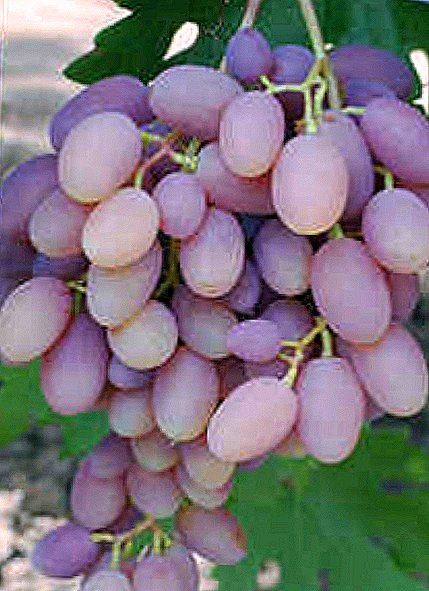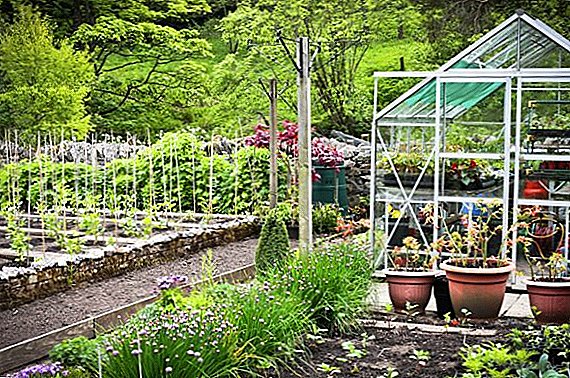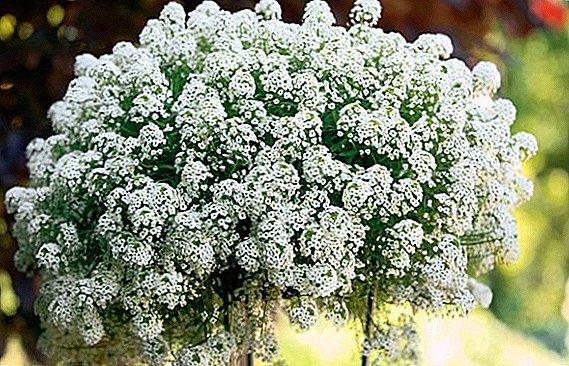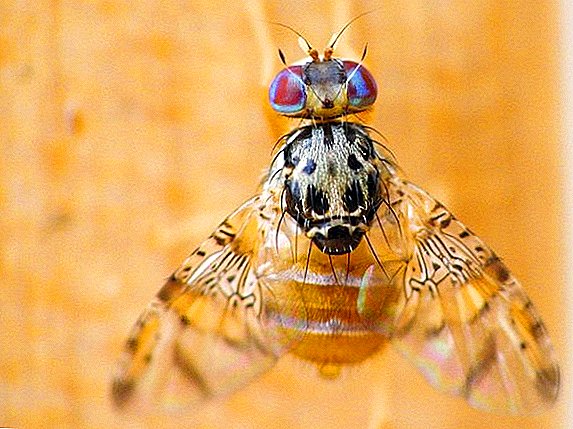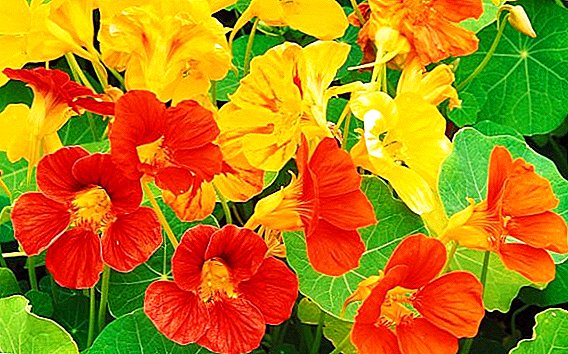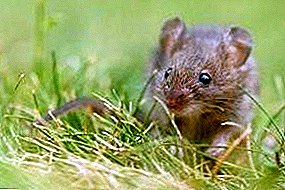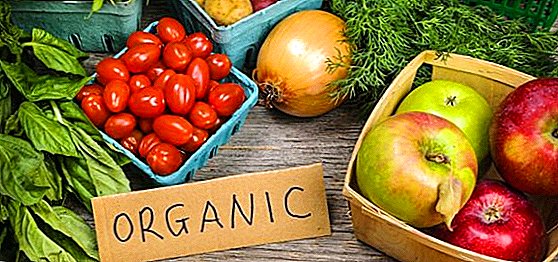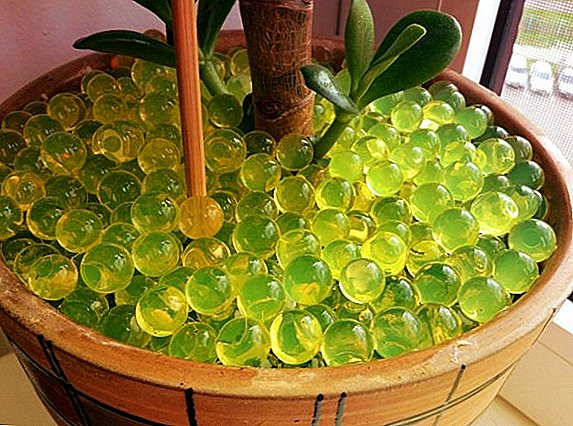 After returning from a long trip, many growers are horrified by the state of their indoor plants, which, in the absence of irrigation, turn into a herbarium. Avoiding this will only help. growing plants in hydrogel, which we will discuss below.
After returning from a long trip, many growers are horrified by the state of their indoor plants, which, in the absence of irrigation, turn into a herbarium. Avoiding this will only help. growing plants in hydrogel, which we will discuss below.
Hydrogel: what is it
 Far from everyone knows what a hydrogel is, although in recent years this substance has become increasingly spread among gardeners. The hydrogel has a very simple composition - it is an ordinary polymer, ground to the state of powder or granules of the most different forms. Its main feature is the ability to absorb a large amount of moisture, which then can either just evaporate or be absorbed by the plants planted in this substance. Thanks to this, even the smallest balls can “swell” to rather large sizes.
Far from everyone knows what a hydrogel is, although in recent years this substance has become increasingly spread among gardeners. The hydrogel has a very simple composition - it is an ordinary polymer, ground to the state of powder or granules of the most different forms. Its main feature is the ability to absorb a large amount of moisture, which then can either just evaporate or be absorbed by the plants planted in this substance. Thanks to this, even the smallest balls can “swell” to rather large sizes.
Did you know? 1 g of polymer granules of hydrogel can absorb 200 g of liquid. Thus, in order to absorb 3 liters of water, only 2 tablespoons of these granules are required.
In the question of what a hydrogel is and why it is needed, there are several ways to use it:
- As a decorative multi-colored substance, with which glass containers are filled and houseplants are planted or are poured into vases with fresh cut flowers.
- As a moisture-accumulating substance, thanks to which flowers can remain for a long period of time without watering.
- As a way to quickly and efficiently deliver nutrients to plant roots.
- As a substance for effective germination of seeds and rooting cuttings.
Important! The hydrogel can absorb not only moisture, but also nutrients diluted in it, which will be delivered directly to the roots of the plant. Therefore, adding hydrogel to the soil mixture to the plants, you can also feed them.
Types of gel soils
Flower hydrogel has two common forms - soft and dense. They differ among themselves not only in their structure, but also in their use, as well as in cost.
Soft hydrogel
 Soft hydrogel for plants has the widest application. It is added to soil mixtures for indoor flowers, for germinating seeds, for planting garden and garden plants. Due to the soft structure and small size of the granules, the roots of any plant can easily penetrate between the granules and inside them, sucking at the same time moisture and minerals.
Soft hydrogel for plants has the widest application. It is added to soil mixtures for indoor flowers, for germinating seeds, for planting garden and garden plants. Due to the soft structure and small size of the granules, the roots of any plant can easily penetrate between the granules and inside them, sucking at the same time moisture and minerals.
This substance is colorless and rarely used alone. Often, it is mixed with soil substrates, which helps to prevent both the acidification of the soil from the introduction of large amounts of moisture and its rapid drying.
Dense hydrogel (aquagrunt)
 This is a more expensive material, which may consist of granules that are larger and more diverse in shape. Due to the high cost akvagrunt completely irrational use in horticulture and gardening. Unlike conventional hydrogel, aquagrunt can include in its composition a variety of dyes, glitters and rhinestones. In this regard, the answer to the question of how to use aquagrunt, appears by itself - it adorns transparent flower pots, and also creates attractive florariums.
This is a more expensive material, which may consist of granules that are larger and more diverse in shape. Due to the high cost akvagrunt completely irrational use in horticulture and gardening. Unlike conventional hydrogel, aquagrunt can include in its composition a variety of dyes, glitters and rhinestones. In this regard, the answer to the question of how to use aquagrunt, appears by itself - it adorns transparent flower pots, and also creates attractive florariums.
Another way to use akvagrunta - a refreshing air. For this purpose, dry granules are filled with water with essential oils or another liquid that has a pleasant aroma. As soon as moisture is absorbed into the granules, they can be arranged in glass vessels throughout the house and long enough to enjoy a pleasant smell. In addition, if children or pets accidentally turn over a pot or a vase with a dense hydrogel, it can be very quickly reassembled, and you don’t even have to vacuum the house.
Important! During the filling with water of multicolored granules of aquagrunt each color must be laid out in different vessels. Stir them is recommended only after complete swelling.
How to apply hydrogel in indoor floriculture
 Hydrogel has no clear instructions for use, so gardeners use it for a variety of purposes. There are practically no restrictions on the question of how to use a hydrogel for indoor plants - some types of plants can be grown directly in it (without forgetting to add some mineral fertilizers) or mixed with a soil substrate. In the latter case, the hydrogel will be useful only for the long-term preservation of moisture in the soil, and at the same time no more than 2 g of dry hydrogel is recommended for 1 l of substrate. This is best done during transfers.
Hydrogel has no clear instructions for use, so gardeners use it for a variety of purposes. There are practically no restrictions on the question of how to use a hydrogel for indoor plants - some types of plants can be grown directly in it (without forgetting to add some mineral fertilizers) or mixed with a soil substrate. In the latter case, the hydrogel will be useful only for the long-term preservation of moisture in the soil, and at the same time no more than 2 g of dry hydrogel is recommended for 1 l of substrate. This is best done during transfers.
When growing flowers exclusively in pure hydrogel, consider several important nuances:
- when using ordinary non-separated water from a tap for irrigation of a hydrogel, the granules may soon become covered with an unattractive bloom or even turn green;
- if the plant has a large root system, it can sprawl around the pot so wide and envelop the hydrogel granules that it will look completely unattractive;
- Some plant species may suffer from lack of air in the hydrogel, so they will have to be transplanted.
Important! Hydrogel polymer granules that you do not use can only be stored in the refrigerator and only in a sealed package. Otherwise, they may crystallize and lose their properties.
Application of hydrogel in the garden
 When it comes to hydrogel, the question of why it is needed in gardening may seem rather complicated, since for large trees tiny granules with water are not capable of playing a large role. However, when it comes to rooting cuttings or reproduction of shrubs by layering, it is the hydrogel that can become the best helper. Also, the hydrogel is used (1: 5 ratio with the ground) when planting young seedlings into the soil, which is not quite suitable for them. First, with the help of a hydrogel, the soil can be made more nutritious, especially if there is a need for mineral fertilizers. Secondly, due to planting plants in a hydrogel and adding it to the soil, it becomes more loose.
When it comes to hydrogel, the question of why it is needed in gardening may seem rather complicated, since for large trees tiny granules with water are not capable of playing a large role. However, when it comes to rooting cuttings or reproduction of shrubs by layering, it is the hydrogel that can become the best helper. Also, the hydrogel is used (1: 5 ratio with the ground) when planting young seedlings into the soil, which is not quite suitable for them. First, with the help of a hydrogel, the soil can be made more nutritious, especially if there is a need for mineral fertilizers. Secondly, due to planting plants in a hydrogel and adding it to the soil, it becomes more loose.
Hydrogel can also be applied to tree trunks of adult fruit-bearing trees. The amount of dry matter used for one tree can vary from 20 to 40 g, which depends on the age of the tree (the older - the more hydrogel will be needed). To apply a hydrogel along the entire perimeter of the near-barrel circle, punctures are made to a depth of 0.5 meters, in which not only the hydrogel is poured, but also mineral fertilizers. After this, the punctures are filled up, and the soil is watered abundantly. Be prepared for the fact that the ground near the tree may rise slightly. Similarly, shrubs can be added, however using 10 g of hydrogel for currants, blueberries and gooseberries, 3 g for raspberries, hydrangeas and roses (it should be no longer than 30 cm to deepen).
Another area of application of the hydrogel in the garden is the removal of excess moisture in the spring, when the level of ground water rises strongly due to the melting snow. In this case, dry hydrogel is also applied to the soil. If we are talking about young seedlings that require a lot of moisture and nutrients, then it is recommended to dig in already swollen granules into the soil around them.
How do gardeners use hydrogel
 In the garden, this substance is used at least, so you should understand how to properly use the hydrogel for plants. In this substance it is very convenient to germinate seeds (which do not have a hard shell) and cultivate seedlings until the very moment of its transplantation into open ground. In addition, part of the hydrogel can be dripped into the beds, so that it retains moisture longer near the roots of the plant. But tomato seedlings can remain in the hydrogel until the very beginning of flowering (it is only important not to forget about additional dressings), which will allow you to get a good harvest and forget about many diseases of this plant, which bushes can infect through the soil.
In the garden, this substance is used at least, so you should understand how to properly use the hydrogel for plants. In this substance it is very convenient to germinate seeds (which do not have a hard shell) and cultivate seedlings until the very moment of its transplantation into open ground. In addition, part of the hydrogel can be dripped into the beds, so that it retains moisture longer near the roots of the plant. But tomato seedlings can remain in the hydrogel until the very beginning of flowering (it is only important not to forget about additional dressings), which will allow you to get a good harvest and forget about many diseases of this plant, which bushes can infect through the soil.
Did you know? A hydrogel is a completely sterile substance in which bacteria cannot grow. In addition, this substance gives moisture to plants very slowly, so you do not have to worry about the possible rotting of the roots of plants.
However, the use of hydrogel for vegetables when they are grown in open ground can play with the gardener and a cruel joke. Hoping that the hydrogel will provide the plants with enough moisture, the gardener can skip several waterings, as a result of which the vegetables can wilt. Therefore, to adapt to the hydrogel and its ability must be extremely careful, especially since in the presence of a hydrogel in the soil of the plant it will be safer to fill with water than to leave it dry.
In general, the use of hydrogel in horticulture is only when growing:
- tomatoes;
- cabbage;
- cucumbers;
- radish;
- potato
VnTo settle the hydrogel granules is about 5 cm deep. If the soil is light, then 1 square. m will require no more than 10-20 g of dry matter, if heavy (loams) - from 20 to 30 g in the same area.
Important! Not all plants respond positively to the use of hydrogel. In particular, eggplant seeds and their sprouts during germination in this substance show very poor growth results.
Hydrogel for plants: the pros and cons of
 Advantages in the use of hydrogel for growing plants, of course, more. Among them is the ability to retain moisture and protect the roots of flowers from its excess, deliver nutrients to the roots, and also make pots of flowers more attractive. However, it is not recommended to use only hydrogel for growing plants. In any case, it should be added nutrients, and watering, though no longer be regular, but still will be needed.
Advantages in the use of hydrogel for growing plants, of course, more. Among them is the ability to retain moisture and protect the roots of flowers from its excess, deliver nutrients to the roots, and also make pots of flowers more attractive. However, it is not recommended to use only hydrogel for growing plants. In any case, it should be added nutrients, and watering, though no longer be regular, but still will be needed.
Another disadvantage of hydrogel is the ability to bloom when the pots are kept under open sunlight. In addition, the same hydrogel can only be used for one plant, since the planting of other species will lose its sterility.
Important! Hydrogel can be used as a drainage when picking up saplings of various plants into separate pots.
The question of whether the hydrogel is harmful is very relevant. This substance does not have any danger, since it itself does not evaporate, and when decomposed, the hydrogel turns into what it consists of - water, carbon dioxide and ammonium harmless to plants. Thus, we can conclude that the composition of the hydrogel is completely harmless, although it is necessary to apply it only taking into account all the above rules and features.  Hydrogel - It is a very useful substance in floriculture and horticulture that can relieve summer residents of the need to water the plants daily. Hopefully, after our article, you will no longer have any questions regarding what hydrogel is made of and how dangerous a hydrogel is when using it.
Hydrogel - It is a very useful substance in floriculture and horticulture that can relieve summer residents of the need to water the plants daily. Hopefully, after our article, you will no longer have any questions regarding what hydrogel is made of and how dangerous a hydrogel is when using it.



